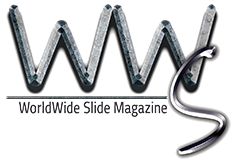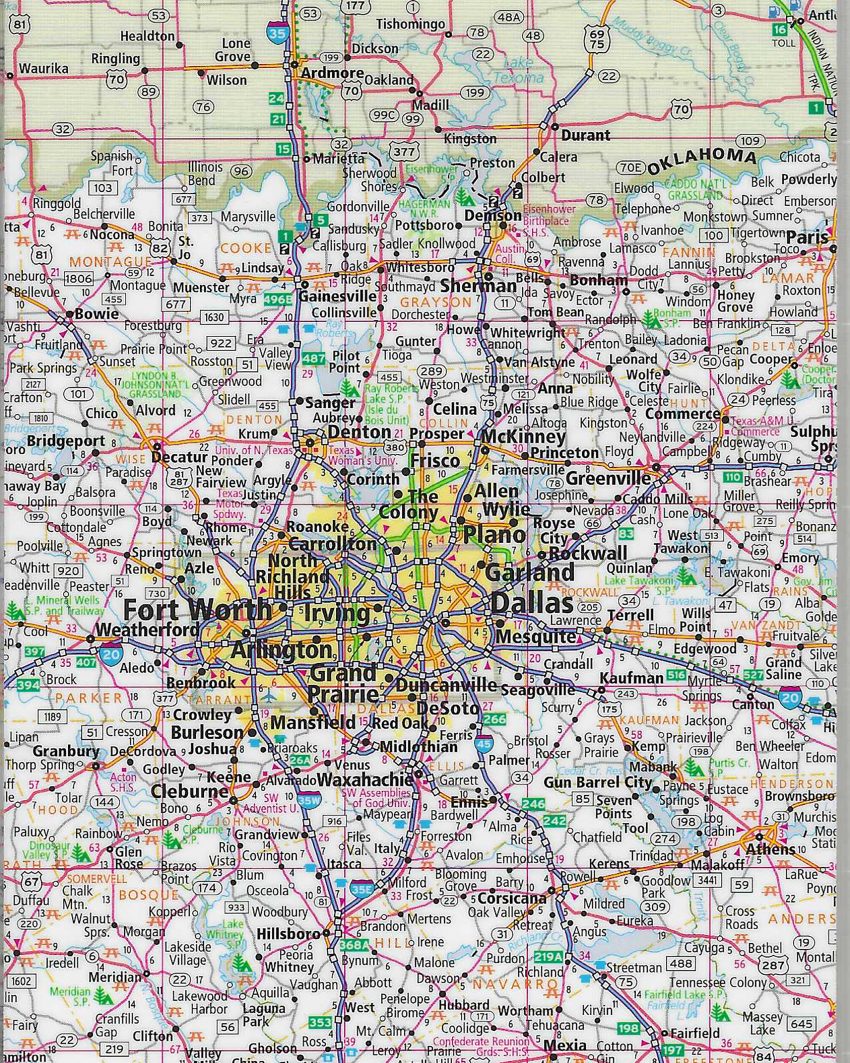Exodus is defined as a departure of a lot of people or in the second book of the Bible the liberation of the people of Israel. The book of Exodus teaches about people’s yearning to be free, but in the early eighties, the Exodus to Texas have been about reiner’s yearning to get out of the cold country.
For many reiners, the Promised Land was Texas. Beginning in the late 1970s, Jack Brainard traveled south first. He was followed by Joe Hayes and then Craig Johnson, Scott McCutcheon, Tim McQuay and others.
Jack Brainard was always entranced by horses. He attended college at Iowa State University (taking a horse with him, of course). Between classes and a part-time job, he spent as much time as possible working with his colt. His life changed when the Japanese bombed Pearl Harbor. Soon, he and his friends were drafted into the Army. He was stationed at Fort Hood in Texas where an injury from a wreck on a Harley Davidson prevented him from leaving when his company was shipped to the Philippines. Once recovered, since he had been to college and could type, he was sent to Alaska.

Near the end of his tour, he was reassigned to Fort Hood, Texas, and life changed when he became friends with Glen Chisum at the nearby Goodrich Ranch. He learned about the newly formed American Quarter Horse Association and when he was discharged, he stayed at the ranch during the winter, riding horses and helping with work. He fell in love with the life and with Texas and vowed he’d live there someday. But his folks needed him closer to home, so he reluctantly moved back.”
He began to be part of the horse world, meeting mentors, studying, learning how to train, showing, succeeding and gradually becoming a universally well-respected horseman. He always wanted to go back to Texas. He had wintered at a facility he rented near Thackerville, Oklahoma a few times. The lure of Texas finally had him moving to a place near I-35 in Gainesville in the late seventies. Although the economy was not good after the oilfield bust, Jack’s mindset was that he’d find a way to make it work and get horses sold.
Brainard became a passionate proponent for other horse people moving south. His son Jody Brainard remembered, “He knew the more people who came down the better business would be so he urged everyone he could to make the move.”
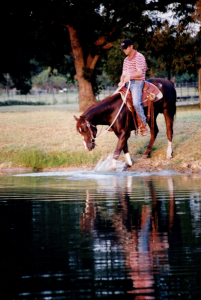
Craig Johnson grew up in Shell Rock, Iowa, the son of Burdette and Ellyn Johnson. His father was a longtime horseman, judge, and a director for the American Quarter Horse Association, so Craig had grown up around horses and the people of the horse world. Craig recalled, “Jack was first to go to Texas. As I grew up, he was like my second dad. When he was still in Minnesota, I spent summers up there. He had me come down and stay with him in Texas early in 1984 after I’d won the Futurity the year before. He told me how he got to ride outside all winter long! That got my attention.”
Craig added, “I decided we would move down there, so we loaded up and set off right after Christmas.. It was kind of tough getting the performance-type horses then. We would have to go sort through cutters and pleasure horses and rope horses to find something that we could make into a reiner. But I knew there were more horses in Texas. “
He recalled one early excursion. “First cutting place I went to, I told them I’d won the reining futurity and would like to look at something that might not have worked out as a cutter. This guy said, ‘Son we don’t have anything that’s washing out that bad!’”
Between the people his dad and Jack knew, Craig got to ride some nice horses – some Doc O’Lenas and Smart Little Lenas. When he first moved down, he rented a house and rode out of Carol Rose’s ranch, then found a place of his own with Joe Hays’ help.
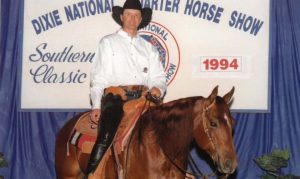
Joe Hayes had moved down about six months earlier, purchasing a place south of Gainesville. Craig remembered, “We went to the lady across from Joe’s place and asked if it could be bought and she said yes.” He purchased the property in 1985.
Craig continued, “I rode a couple for Carol when I moved down. She had Sparkles Rosezanna that year. She was so proud of that mare. When I got the place, Carol wouldn’t let me keep her mare there. So, every day, we’d load her up and bring her to my place to ride. I’d train her, then load her back on the trailer and take her home.”
After he piloted the mare to win the 1985 NRHA Futurity, Carol finally let him keep a horse at his barn.
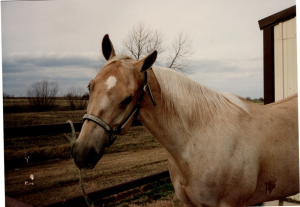
He added, “I think Carol just decided that horses should be worth more, and she was right. In 1983 I won the NRHA Futurity on Lucky Day Glo. When that horse sold for $7,500, I was so excited and hadn’t heard of a reining horse selling for that much. Two years later, I’m pretty sure Carol turned down $100,000 for Sparkles Rosezanna. I think it used to be the cheapest thing you could buy was a trainer’s time – but they finally figured out what training was worth.”
Joe Hayes would have an integral effect in bringing many others in the reining world to Texas. Known universally as one of the nicest guys in the industry, he loved three things besides his family – the NRHA, the people of reining , along with judging horse shows and being part of the judging world. And his belief that Texas was a great place for reiners was contagious.
With a little history of Joe’s history, you can get a feel for how all that evolved. He was raised on the family dairy in upstate New York. The work ethic from that labor-intensive environment where he got up each morning at 3:30 a.m. to do chores would stay with him throughout his life.
Joe attended college at Cornell University and got interested in horses, ultimately deciding that he wanted them to be his future. After college, he wrote Howard Pitzer asking for a job. Howard, an AQHA Hall of Fame member, was standing Two Eyed Jack, at that time the all-time leading sire of AQHA Champions, and the Pitzer Ranch program was one of the most prominent in the industry. The ranch was located in the Sandhills region northwest of Ericson, Nebraska.
Not surprisingly, Pitzer didn’t think this unknown, would-be cowboy from New York would fit his program. Undeterred, Joe kept writing him. Two years later, Pitzer finally relented, and Joe began his tenure there cleaning stalls. As his skills grew, he started showing some of the horses and started roping. That’s where he met Bob Loomis and ultimately went to work for him.
Joe moved south to Marietta, Oklahoma with Loomis when he relocated. That move came following an early trip where Craig, Bob, and Doug Milholland had met in Wichita, Kansas, and driven south in Bob’s motor home to look at potential places to move. Craig remembered, “We met in Wichita and looked at places in Texas and Oklahoma. I knew more cutters in Texas, so I liked that better. Land in Oklahoma was cheaper and Bob wanted more land so that’s how he ended up there.”
Joe had originally planned to work for Bob for seven years or so before going out on his own. He thought he would like to live in Weatherford, Texas, at the end of that time, and began to plan for the move. He was at a show with Bill Horn who asked him why in the world he wanted to move to Texas, noting, “There are just cutters and pleasure horses there!” Joe said he thought that Texas was where the reiners would ultimately be.
On the way home from looking at places at Weatherford one day, Joe traveled back through Gainesville. When he saw a for sale sign at a place with dairy farms all around, he somehow knew that was the place he’d call home. He was convinced that reining was coming to Texas. Hence the entrance sign that he often got kidded about in the early days that read, “Its Reining in Texas.”
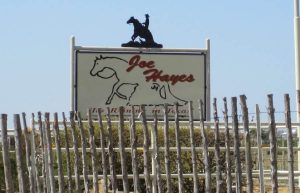
Liz Hayes met her future husband in 1988 on a trip south. She showed reiners with Dutch Chapman and had gone to Congress and to the NRHA Futurity. “My best friend, Carol Cross, had horses in the Futurity,” she explained.
Admittedly, from a matchmaker’s perspective, Carol urged Liz to meet Joe. “Carol set up a meeting with Joe for him to take me around to see horses. I met him the night after the Futurity at the banquet. I was talking to Mary Hannagan and told her I was going to look for horses, and that my friend had me set up with an appointment with Joe Hayes. She told me he was the nicest guy and I could meet him right then. So, she took me over and introduced me, and it was pretty embarrassing,” Liz recalled.
Liz didn’t know many of the reiners. The only one she could recognize was Bob Loomis, because she knew he always dressed in black. So, when young men had tried to talk to her at the show, Liz would brush them off. It had happened a few times earlier in the week. Then she was introduced to Joe. “He was sitting at the table with some Italians and said, ‘Well you’re finally going to speak to me!’” she recalled. Joe had been the one trying to talk to her for days. They married a little over three years later in 1992.
Early on, Joe and Craig alternated putting on clinics and shows at their places. Their Oklahoma counterparts, Bob Loomis and Dick Pieper, were doing the same at their ranches just north of the Red River.
These shows became the roots of the Southwest Reining Horse Association. Liz said, “We’d not only show horses, but we would also have dog races! Lynn Wild ran a catering truck. She was quite a cook and people loved her food. I think they’d go to the reining just to eat.”
Craig laughed, “We’d put on the shows, and we did everything. Sarah (Craig’s daughter) would have a lemonade stand. Lemonade was free, but cups were a dollar! We lived next door to a dairy farm and the north arena fence backed up to a pasture with about 100 black and white cows. I’d ride every day out there so my horses were OK with that, but at the shows, we’d sometimes have to take a lunch break if they were all lined up at the fence watching!”
Liz agreed. “It was a magical time and the Southwest seemed like a big family. It was a community effort to get it going so everyone did a lot of work. Elizabeth Reeves, Brenda Pieper, and Kay Laske would all be helping then others would help so the people in the office could go show,” she said.
The shows didn’t cost a lot and enabled local people who had horses to learn about reining. Craig recalled, “After a few years the shows got so big we had to finish up showing the last horses with truck headlights shining on the arena.”
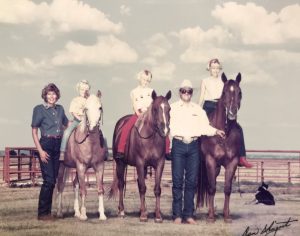
Scott and Kathy McCutcheon were among the next families that made the southward pilgrimage. “We always came to Texas to buy horses and to sell horses and to show horses,” Kathy explained.
They were renting a facility in Eau Claire, Wisconsin. “It was beautiful but remote and very hard to get people to come look at horses. The owners wanted to sell it, but we didn’t think it was right for our future, so it seemed like the time to move somewhere,” she said.
The family of four moved out of that facility and in with Scott’s parents Bob and Jan. They boarded their horses at nearby River Falls, and their four dogs lived in the horse trailer.
They knew they needed to move. It was the summer of 1988 right before the NRHA Derby. Kathy was eight months pregnant. Scott flew down with a camera and took videos of a place in Gainesville that Craig and Joe had told him about, owned by Molly Arrowsmith.
“He brought the video back and said, ‘What do you think?’ I said, ‘Since it’s our only option it will work,’” Kathy recalled.
They packed and headed south – Scott and Kathy, two little kids, five dogs, and the horses. The priority, before even unpacking, was to find an obstetrician. Their daughter, Jodie, was born 11 days after they arrived.
Scott’s brother Tom and friend Phil Solum had been designated to drive the U-Haul trailer with all the McCutcheon’s personal items in it. They were in a collision with a truck and a boat trailer that shattered some of the McCutcheon trailer’s contents. Kathy said, “We had hauled a thousand miles and we’d put Tom and Phil in charge of our personal belongings. But then I thought the most important thing was that we’d all made it, and everyone was safe so it wasn’t that bad.”
Scott ended up riding horses for Molly and they discussed purchasing the facility, but it never worked out. So, eight years after moving to Texas they bought their current facility in Whitesboro,
Scott noted, “The world decided that north Texas was a great place to be – and it is. It’s spectacular that you can jump into the car and drive a short way and look at some of the best horses in the world!”
More people began to look at Texas as an option. Craig said, “We knew it was easier to ride horses that were bred to be reiners, and the breeding programs were being created – Bob was the leader. The cutting studs were here, but the bottom line was that when the reining studs came, the people would follow.“
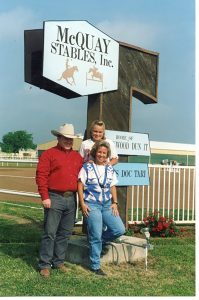
That was accelerated when Tim and Colleen McQuay moved to Tioga, Texas, in 1989. Like others, Tim had heard Brainard’s entreaty, “Come on down here!”
But for the McQuays, there were multiple reasons to think of moving. Colleen explained, “For me, it was pretty simple. Thinking of our future, we could look around Minnesota and didn’t see many 50-year-old horse trainers making a living. I was already showing hunters and jumpers at a winter circuit in Arizona and would finish in March and come back to Minnesota. In addition to the freezing weather, there was no sun. You learn how much of a handicap you work under in those cold conditions.”
The couple had purchased Hollywood Dun It and had one year of breeding in Minnesota where they bred 60 mares. Tim wanted to be in the breeding business. “It took me five years to convince Tim we should move. There was not enough business opportunity in that part of the country where you’d almost go dormant six months a year. Ultimately though it was the weather and how hard that made the breeding business that convinced Tim,” she explained.
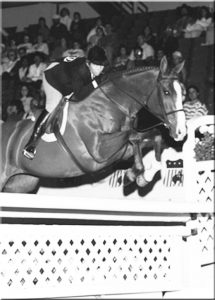
Colleen chose to show her hunters at a circuit in Texas one year, then every Monday and Tuesday she would shop for real estate in her off time. “We could have gone different directions, but Dallas was most logical. It had a major airport where you could fly direct to most places, plus there was a thriving hunter and jumper presence in the area.” She added, “Bob Loomis said to be sure to get south of the Arbuckle Mountains in Oklahoma because the weather is better there. I didn’t know that Oklahoma had mountains or what mountains he was talking about but thought if we were moving, we were not going where we would have bad winters!”
Based on all factors, the McQuays decided they needed to be in Texas. Darlene Turner was a client – and they found that the Ted Turner farm in Tioga was for sale. The McQuays negotiated to make a deal to buy. Luckily, things fell in place to sell their farm in Minnesota when a friend from the hunter world had a customer that would buy it. The buyer wanted possession within 48 hours of closing so the move was on.
The 100-acre Tioga facility that would become home to some of the industry’s most iconic horses had a different look then. As a halter farm, there was no indoor or outdoor arena, just a covered round pen, a main barn, and a breeding barn with an open-faced mare motel.
The first indoor arena came when Colleen sold a hunter. She remembers, “People laughed at us. At that point Scott had one, but most people rode outside. Tim said he didn’t want to take the chance of not getting his horses ridden because of weather. We built one and learned you use it to get out of sun as much as rain or weather.”
The move and the burgeoning success of Hollywood Dun It would bring new visitors and ultimately new residents to the area. “In those days, the mares had to be on the property, so people came to bring their mares. They’d come to bring mares and stay to ride or to visit. It was a reason to take a trip,” Colleen shared.
At the same time, reining was beginning to go global. “All through the nineties we had so many foreigners there and so many interns that came from Europe.”
There was one very important benefit of the move. “It gave us an opportunity to reset – in Minnesota we had to do anything to have enough horses. We had to take clients that hauled in, and I learned how hard it was to ride those horses that way. When we came to Texas, we set new, more functional policies,” Colleen said.
With both McQuays handling thriving businesses came the necessity of having an actual office and full-time secretary – a novel concept for horse training facilities in the ‘80s. In the north Texas reining community, that meant everyone had a secretary, sort of.
The McQuay’s secretary, Helen Wilson, became a community resource of sorts. Colleen recalled, “A lot of people would call Helen for phone numbers and vendor information. She became a kind of central office for the area because we gathered information and she always had it on hand.”
The McQuays would be in the facility for 30 years, but at first, Colleen wondered if it would ever really seem like home. She still remembers heading to the NRHA Derby the last year it was in Minnesota. “Dun It was doing good, and we knew business-wise we had made a good decision, but when we left for Minnesota, I wondered if we would feel we missed being there. Then I remember coming back to Texas and driving into the driveway and thinking, ‘No, this feels like home.’”
Steadily, people moved into the North Texas area. The European influence helped with more people buying properties and providing jobs or places to rent.
Colleen mused, “Industry had as much influence as weather. The NRBC was influential, and before long you had the industry’s three major events in Texas and Oklahoma. That was a calling card. Industry and weather and facilities influence any migration. But I really don’t think we were smart enough to think the industry would grow like it has.”
